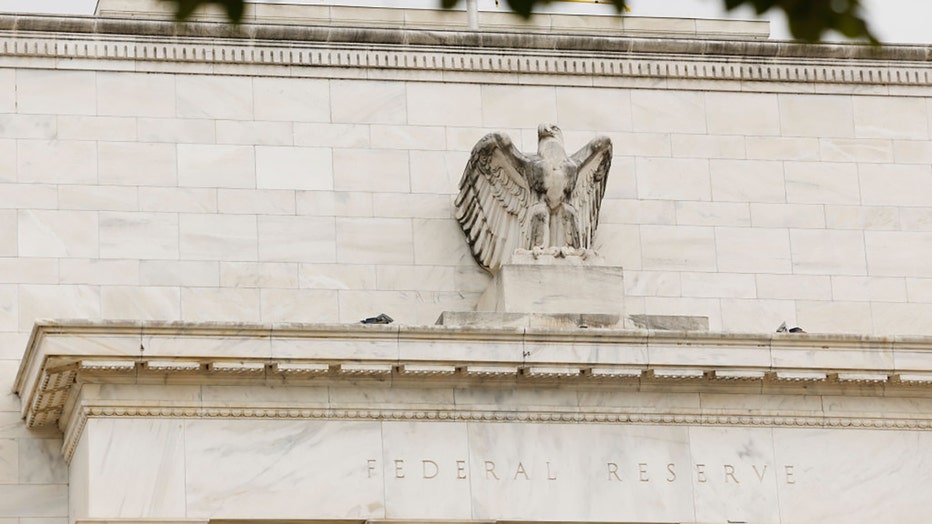Federal Reserve slashes key rate by half-point, signals end of inflation battle
WASHINGTON - The Federal Reserve cut its benchmark interest rate by an unusually large half-point, a dramatic shift after more than two years of high rates helped tame inflation but that also made borrowing painfully expensive for consumers.
The rate cut, the Fed’s first in more than four years, reflects its new focus on bolstering the job market, which has shown clear signs of slowing. Coming just weeks before the presidential election, the Fed’s move also has the potential to scramble the economic landscape just as Americans prepare to vote.
Fed hinted at cutting rate

FILE - A statue of an eagle is seen on the Federal Reserve building on Sept. 17, 2024, in Washington, D.C. (Photo by Anna Moneymaker/Getty Images)
With inflation barely above their target level, Fed officials have been shifting their focus toward supporting a weakening job market and achieving a rare "soft landing," whereby it curbs inflation without causing a sharp recession, the AP reported.
A half-point rate cut signal sthat the Fed is as determined to sustain healthy economic growth as it is to conquer high inflation.
High interest rates and elevated prices for everything from groceries to gas to rent have fanned widespread public dissatisfaction with the economy.
Fed interest rate cuts: What does it mean for you?
Over time, Fed rate cuts can have an impact to varying degrees on borrowing costs for auto loans, mortgages and credit cards, as well as for business loans.
Business spending could grow, and so could stock prices.
Companies and consumers could refinance loans into lower-rate debt. And even just a minor change in credit card rates can affect how much Americans owe.
Powell made clear last month in a high-profile speech in Jackson Hole, Wyoming, that Fed officials feel confident that inflation has largely been defeated.
Wage growth has slowed, removing a potential source of inflationary pressure. And oil and gas prices are falling, a sign that inflation should continue to cool in the months ahead. Meanwhile, consumers are also pushing back against high prices – forcing such companies as Target and McDonald's to dangle deals and discounts.
RELATED: McDonald's $5 value meal is sticking around longer at most US locations
Inflation plummeted from a peak of 9.1% in June 2022 to 2.5% last month, not far above the Fed's 2% target. Central bank officials fought against spiking prices by raising their key interest rate 11 times in 2022 and 2023 to a two-decade high of 5.3% to try to slow borrowing and spending, ultimately cooling the economy.
Yet after several years of strong job growth, employers have slowed hiring, and the unemployment rate has risen nearly a full percentage point from its half-century low in April 2023 to a still-low 4.2%. Once unemployment rises that much, it tends to keep climbing. But Fed officials and many economists note that the rise in unemployment largely reflects an increase in new workers seeking jobs — notably new immigrants and recent college graduates — rather than layoffs.
Still, Powell said in Jackson Hole in August that "we will do everything we can to support a strong labor market." He added that any "further weakening" in the job market would be "unwelcome."
Some analysts have said that such a sweeping declaration suggests that Powell would favor a half-point rate cut. Other economists still think a quarter-point reduction is more likely.
Fed cuts and mortgage rates
Fixed mortgage rates aren’t set by the Fed, but rather by investors, according to the personal finance site Bankrate. It notes that the most important benchmark for mortgage rates is the 10-year Treasury rate, and mortgage rates tend to move up and down with that rate, "which itself bounces around with economic sentiment."
And as Powell and other Fed officials have signaled that rate cuts are coming, many borrowing rates have already fallen in anticipation.
The average 30-year mortgage rate, for example, dropped to 6.2% last week — the lowest level in about 18 months and down from a peak of nearly 7.8%, according to the mortgage giant Freddie Mac.
"Mortgage rates move with the bond market, and if the Fed cuts rates, that is an indication that the economy is weakening and will support lower yields and lower mortgage rates," Melissa Cohn, regional vice president of William Raveis Mortgage, told Bankrate. "Remember, mortgage rates are not tied directly to the Fed funds rate. They move with the bond market, which moves on economic data."
Jerimiah Taylor, chief real estate officer at Movoto, a real estate search site, echoed that sentiment.
"I think a lot of people are looking at the September Fed meeting thinking that there’s going to be a big stair step down in rates," Taylor told Bankrate. "The reality is that it’s already priced in. You’re getting disproportionate movement in mortgage rates, which means the market is already starting to price in Fed cuts."

